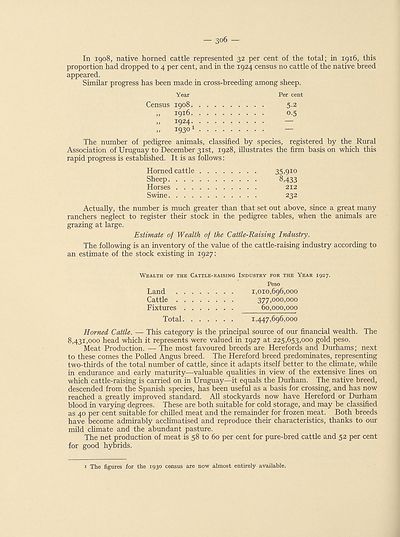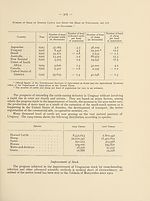Download files
Complete book:
Individual page:
Thumbnail gallery: Grid view | List view

3°6 —
In 1908, native horned cattle represented 32 per cent of the total; in 1916, this
proportion had dropped to 4 per cent, and in the 1924 census no cattle of the native breed
appeared.
Similar progress has been made in cross-breeding among sheep.
Year Per cent
Census 1908 5.2
„ 0.5
» 1924 —
,, 19301 —
The number of pedigree animals, classified by species, registered by the Rural
Association of Uruguay to December 31st, 1928, illustrates the firm basis on which this
rapid progress is established. It is as follows:
Horned cattle 35 »910
Sheep 8,433
Horses 212
Swine 232
Actually, the number is much greater than that set out above, since a great many
ranchers neglect to register their stock in the pedigree tables, when the animals are
grazing at large.
Estimate of Wealth of the Cattle-Raising Industry.
The following is an inventory of the value of the cattle-raising industry according to
an estimate of the stock existing in 1927:
Wealth of the Cattle-raising Industry for the Year 1927.
Peso
Land 1,010,696,000
Cattle 377,000,000
Fixtures 60,000,000
Total 1,447,696,000
Horned Cattle. — This category is the principal source of our financial wealth. The
8,431,000 head which it represents were valued in 1927 at 225,653,000 gold peso.
Meat Production. — The most favoured breeds are Herefords and Durhams; next
to these comes the Polled Angus breed. The Hereford breed predominates, representing
two-thirds of the total number of cattle, since it adapts itself better to the climate, while
in endurance and early maturity—valuable qualities in view of the extensive lines on
which cattle-raising is carried on in Uruguay—it equals the Durham. The native breed,
descended from the Spanish species, has been useful as a basis for crossing, and has now
reached a greatly improved standard. All stockyards now have Hereford or Durham
blood in varying degrees. These are both suitable for cold storage, and may be classified
as 40 per cent suitable for chilled meat and the remainder for frozen meat. Both breeds
have become admirably acclimatised and reproduce their characteristics, thanks to our
mild climate and the abundant pasture.
The net production of meat is 58 to 60 per cent for pure-bred cattle and 52 per cent
for good hybrids.
1 The figures for the 1930 census are now almost entirely available.
In 1908, native horned cattle represented 32 per cent of the total; in 1916, this
proportion had dropped to 4 per cent, and in the 1924 census no cattle of the native breed
appeared.
Similar progress has been made in cross-breeding among sheep.
Year Per cent
Census 1908 5.2
„ 0.5
» 1924 —
,, 19301 —
The number of pedigree animals, classified by species, registered by the Rural
Association of Uruguay to December 31st, 1928, illustrates the firm basis on which this
rapid progress is established. It is as follows:
Horned cattle 35 »910
Sheep 8,433
Horses 212
Swine 232
Actually, the number is much greater than that set out above, since a great many
ranchers neglect to register their stock in the pedigree tables, when the animals are
grazing at large.
Estimate of Wealth of the Cattle-Raising Industry.
The following is an inventory of the value of the cattle-raising industry according to
an estimate of the stock existing in 1927:
Wealth of the Cattle-raising Industry for the Year 1927.
Peso
Land 1,010,696,000
Cattle 377,000,000
Fixtures 60,000,000
Total 1,447,696,000
Horned Cattle. — This category is the principal source of our financial wealth. The
8,431,000 head which it represents were valued in 1927 at 225,653,000 gold peso.
Meat Production. — The most favoured breeds are Herefords and Durhams; next
to these comes the Polled Angus breed. The Hereford breed predominates, representing
two-thirds of the total number of cattle, since it adapts itself better to the climate, while
in endurance and early maturity—valuable qualities in view of the extensive lines on
which cattle-raising is carried on in Uruguay—it equals the Durham. The native breed,
descended from the Spanish species, has been useful as a basis for crossing, and has now
reached a greatly improved standard. All stockyards now have Hereford or Durham
blood in varying degrees. These are both suitable for cold storage, and may be classified
as 40 per cent suitable for chilled meat and the remainder for frozen meat. Both breeds
have become admirably acclimatised and reproduce their characteristics, thanks to our
mild climate and the abundant pasture.
The net production of meat is 58 to 60 per cent for pure-bred cattle and 52 per cent
for good hybrids.
1 The figures for the 1930 census are now almost entirely available.
Set display mode to:
![]() Universal Viewer |
Universal Viewer | ![]() Mirador |
Large image | Transcription
Mirador |
Large image | Transcription
Images and transcriptions on this page, including medium image downloads, may be used under the Creative Commons Attribution 4.0 International Licence unless otherwise stated. ![]()
| League of Nations > Economic and financial section > Agricultural crisis > Volume 1 > (310) |
|---|
| Permanent URL | https://digital.nls.uk/190906680 |
|---|
| Shelfmark | LN.II.2/2.(35) |
|---|---|
| Attribution and copyright: |
|
| Shelfmark | LN.II.2/2.(35-35) |
|---|---|
| Shelfmark | LN.II |
|---|
| Description | Over 1,200 documents from the non-political organs of the League of Nations that dealt with health, disarmament, economic and financial matters for the duration of the League (1919-1945). Also online are statistical bulletins, essential facts, and an overview of the League by the first Secretary General, Sir Eric Drummond. These items are part of the Official Publications collection at the National Library of Scotland. |
|---|---|
| Additional NLS resources: |
|

